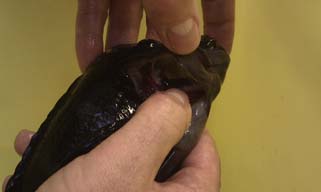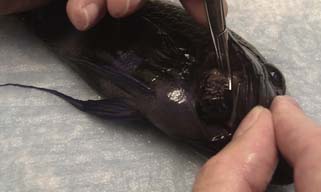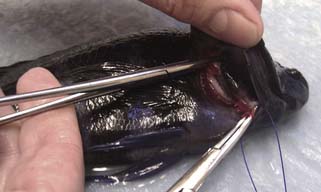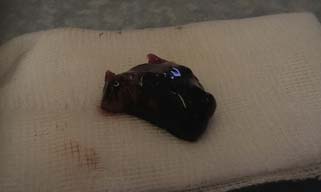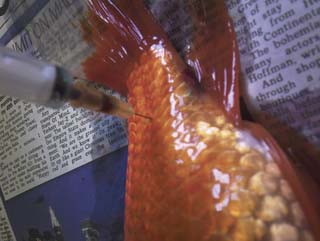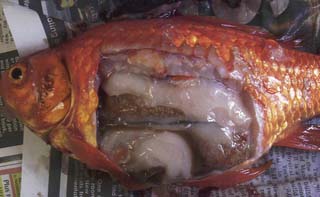Chapter 5 Fishes
Case 5.1
Clinical history
• A large, black swelling was visible on the first gill arch on the right hand side
• This female had a relatively recent history of not brooding her egg clutches to full term
Physical examination
The fish was netted and the gills briefly examined by alternately lifting the operculae with the fish restrained in the net. A dark mass could be seen associated with the gills on the right hand side (Fig.5.1).
Clinical diagnosis examination
Therapy
![]() 2. What treatment options are available to you?
2. What treatment options are available to you?
Treatment options are limited but would include:
• Biopsy and appropriate treatment for non-neoplastic conditions
• Surgical debulking. Possible but risky in view of the potentially highly vascular tissue involved
• Surgical debulking followed by weekly cisplatin injections may be considered for skin tumours, but again this mass is in a very vascular area and surgical debulking and chemotherapy may be highly risky.
It was elected to remove the mass surgically. This was achieved by resection of the first branchial arch. This was clamped at either end and ligated with PDS (Fig.5.3). Antibiotic cover was provided with an intramuscular injection of 1 mg marbofloxacin. Recovery involved placing the cichlid back into water that did not contain MS222.
The mass was some 2.0 cm in diameter and was submitted for histological examination (Fig.5.4).
Discussion
A variety of gill neoplasms have been recorded including papillomas, squamous cell carcinomas, branchioblastomas and chondromas (Childs and Whitaker 2001). Sarcomas have been well described in a variety of fish (Earnest-Koons etal. 1996, Lewbart etal. 1998, Schmale etal. 2002), although their presence in cichlids does not appear to have been widely reported. In the walleye, dermal sarcomas are due to a retroviral infection and can be transmitted (Earnest-Koons etal. 1996) – interestingly, other sarcomas in fish appear to be linked to viral agents or at least a virus-like agent (Schmale etal. 2002),
Childs S., Whitaker B.R. Respiratory disease. In: Wildgoose W.H., ed. BSAVA Manual of Ornamental Fish. second ed. Gloucester: British Small Animal Veterinary Association; 2001:145.
Earnest-Koons K., Wooster G.A., Bowser P.R. Invasive walleye dermal sarcoma in laboratory-maintained walleyes Stizostedion vitreum. Dis. Aquat. Organ.. 1996;24:227–232.
Lewbart G.A., Spodnick G., Barlow N. Surgical removal of an undifferentiated abdominal sarcoma from a koi carp (Cyprinus carpio. Vet. Rec.. 1998;143(20):556–558.
Schmale M.C., Gibbs P.D.L., Campbell C.E. A virus-like agent associated with neurofibromatosis in damselfish. Dis. Aquat. Organ.. 2002;49:107–115.
Case 5.2
Post-mortem diagnosis examination
Initially a skin scrape was taken, and then both fish were euthanased with intravenous pentobarbitone (Fig.5.5). A post-mortem examination was then undertaken. The first goldfish weighed 179 g and had a standard length of 152 mm. The results for this first goldfish are:
Gill squash
 Huge numbers of these parasites were found
Huge numbers of these parasites were found
 Normal gill lamellar architecture disrupted. Significant clubbing of lamellae
Normal gill lamellar architecture disrupted. Significant clubbing of lamellae
![]() 1. What are these parasites likely to be?
1. What are these parasites likely to be?
![]() 2. Why is it important to distinguish between Dactylogyrus and Gyrodactylus?
2. Why is it important to distinguish between Dactylogyrus and Gyrodactylus?
On examination of the coelomic cavity, the fish was revealed to be female with well-developed ovaries showing evidence of asynchronous egg development. The carcass was very fatty and the caudal kidney appeared very soft with a loss of normal texture. The spleen appeared enlarged (Fig.5.6).
Histopathology results
 Gills: severe hyperplasia of the branchial epithelium, from the base to the tip of the primary lamella. The basal filament epithelium is severely proliferative such that secondary lamellae are frequently obscured. The lamina propria is moderately infiltrated by mixed leucocytes and the vasculature is engorged. Between the filaments, there are innumerable, transverse to oblique to rarely longitudinal sections of metazoan parasites approximately 30–100 μm in diameter, with an eosinophilic cuticle, parenchymatous body, no visible digestive tract and occasionally visible sucker. Some of the organisms show either internal ova or internal spermatozoa
Gills: severe hyperplasia of the branchial epithelium, from the base to the tip of the primary lamella. The basal filament epithelium is severely proliferative such that secondary lamellae are frequently obscured. The lamina propria is moderately infiltrated by mixed leucocytes and the vasculature is engorged. Between the filaments, there are innumerable, transverse to oblique to rarely longitudinal sections of metazoan parasites approximately 30–100 μm in diameter, with an eosinophilic cuticle, parenchymatous body, no visible digestive tract and occasionally visible sucker. Some of the organisms show either internal ova or internal spermatozoa
 Hepatopancreas: this section also contained free pancreatic tissue and adipose tissue. The hepatocytes contained occasional proteinaceous droplets. Two small granulomas were present in the serosa and adjacent adipose tissue near the free pancreas
Hepatopancreas: this section also contained free pancreatic tissue and adipose tissue. The hepatocytes contained occasional proteinaceous droplets. Two small granulomas were present in the serosa and adjacent adipose tissue near the free pancreas
 Spleen: free pancreatic tissue was attached here too. There were a few tiny granulomas in the interstitial tissue between the spleen and adjacent fragments of free pancreas
Spleen: free pancreatic tissue was attached here too. There were a few tiny granulomas in the interstitial tissue between the spleen and adjacent fragments of free pancreas
 Head kidney: tubular epithelial cells frequently contained proteinaceous material. Otherwise all appeared normal
Head kidney: tubular epithelial cells frequently contained proteinaceous material. Otherwise all appeared normal
Stay updated, free articles. Join our Telegram channel

Full access? Get Clinical Tree


